Unprocessed FAQ: Flours & Grains
Sep 26, 2019

In today’s October Unprocessed FAQ, I’m going to try to clear up some confusion surrounding one of our most common ingredients: Flours and grains.
“Intact” Grains
Although you probably won’t hear “intact” very often when it comes to grains (it’s not common on labels), it’s the best word I’ve found to describe them. The idea is that it’s the whole grain, completely intact as nature made it — it hasn’t been cut, ground, or pulverized in any way. When you buy a bag of whole kernels of barley, wheat, rye, farro, kamut, spelt, teff… all that’s been done to it is that it’s been harvested, cleaned, and dried (and, if it’s not organic, probably sprayed with pesticides). You could do all that at home (though it’s probably not worth the effort!), so those totally pass the kitchen test.
“Whole” Grain
Anything that includes the entirety of the grain — the bran, germ, and endosperm — can be called “whole grain,” even if it’s been ground up (or even separated and put back together). Steel-cut oats, for example, would be whole grain, since they start with intact oats, and then cut them with steel blades. (Here’s more on oats and oatmeals.)
Here are some of the things to watch out for on labels when you’re shopping for whole grain products.
“Whole Grain Flour”
This is really just taking the grain and grinding it down even more, until it’s a fine powder. For it to be called “whole,” it still needs the bran, germ, and endosperm — though technically, it’s legal to separate all the components and then put them back together.
In a previous October, Cassidy from Bob’s Red Mill shared a very informative post about flour — it’s well worth the read.
Refined Flours, or simply: “Flour”
It’s safe to assume that anything called “flour” without the word “whole” preceding it has been refined — it’s lacking the nutrient-rich germ and bran. It might be called “All Purpose Flour,” or “Unbleached Flour” or simply, “Wheat Flour.”
By law in the United States, unless it’s certified organic, manufacturers are required to add back in some vitamins, because the refining process strips them out. In Canada, even organic flour must be enriched.
Theoretically, you could grind your own grains at home, and then take the resulting whole grain flour and pass it through finer and finer sieves, until you’ve sifted out all the bran and germ, leaving just the light endosperm. You’d probably never do it, but in theory you could.
To bring this back to the Kitchen Test, then: Strictly speaking, “unbleached, unenriched flour” will pass the test. (That does not mean I’m suggesting you eat it.) But if it’s been bleached or enriched — two things you wouldn’t do at home — it doesn’t pass the test.
Watch out for the “Wheat Bread” trick that many companies and restaurants play, trying to make you think it’s healthier than any other bread. All it means is that it’s made with wheat flour, which is most likely refined. Your best bet is to get “100% Whole Wheat Bread,” and short of that, seek out “Whole Wheat Bread.”
“White Flour” and “White Whole Wheat Flour”
This is very confusing. Most flour (whole or refined) these days comes from a species of wheat called “red wheat.” If you buy a bag of white flour, it’s probably been milled and refined (and bleached) from red wheat. However, “White Whole Wheat” refers to whole wheat flour that comes from “white wheat,” a different species.
So regular wheat flour probably comes from red wheat. “White Whole Wheat Flour” actually comes from white wheat. Got it? (If not, check out this on Wikipedia.)
Recently, Bob’s Red Mill rebranded their “Organic Hard White Whole Wheat Flour” (pictured above) as “Organic Ivory Wheat Flour” – I’m guessing to help reduce some of this confusion.
Matty and I prefer using White (Ivory) Whole Wheat Flour at home, because it’s a little bit less dense than the red wheat, so it makes a slightly lighter loaf of bread (or pizza crust!). Both Red Wheat and White Wheat have effectively the same nutrition, so that’s not really a concern.
“Sprouted” Grains
Grain kernels are actually the seeds of a plant–so sprouted grains are simply seeds that are starting to grow (nowadays, that means they’ve been deliberately germinated). They’ve become popular recently because they’re more easily digestible and nutritious. I’m not convinced there’s a huge health benefit–but I also don’t think they will hurt, and may indeed provide at least some benefits. I’ve also found that store-bought breads that promote the fact that they’re made with sprouted grains are more likely to be healthier overall and pass the kitchen test (such as Ezekiel 4:9 and Alvarado Street Bakery), so I usually pick those up from the shelf first.
(Sidenote: Watch out for raw alfalfa sprouts and bean sprouts, like you’d find on a salad bar – unfortunately they’re now a common source of food poisoning. That’s not an issue with grains, which you’re going to cook anyway.)
White Rice and Pearl Barley
White rice is a common question — it’s basically brown rice that has had the outer layers of the grain removed, or “polished.” The question then becomes, can this be done at home, at least in theory? I found this forum post that shows someone doing it at home, and you can even buy a countertop rice polisher on Amazon (looks like they all ship directly from Japan, which sounds about right). I think the process is similar for pearl barley. So I’d say that this does pass the test… of course, from a nutritional perspective, I think we’re better off eating brown rice instead.
Quinoa
While technically not a grain (it’s a “pseudocereal” since it’s not a member of the grass family), for our purposes it might as well be. Quinoa (pronounced “keen-wah”) is great stuff: high in nutrition; a wonderful, nutty flavor; and great hot or cold. Here’s how to make fluffy quinoa.
Gluten-Free Flours
Carrie Vitt wrote a guest post during a previous challenge, outlining many of the gluten-free flours and grain-free flours that have flooded the market in recent years, so definitely go check that out if you’re wondering about those.
Applying This Info for the Challenge
100% Whole Grain Flour and unbleached, unenriched flour both pass the kitchen test. Bleached and/or enriched flours do not. So read the labels, and eat accordingly!
—
Did I miss anything? Let us know in the comments section below.
If you haven't taken the October Unprocessed pledge yet, please do! And then encourage your friends to join in -- it's a lot more fun that way!
Wheat © 2014 Brad Higham.
Jars of Whole Grains © 2014 Annie Corrigan/WFIU Public Radio.
Bobs Red Mill Organic White Whole Wheat Flour © 2009 Sarah Gilbert.
Sprouted Wheat Berries © 2010 Veganbaking.net.
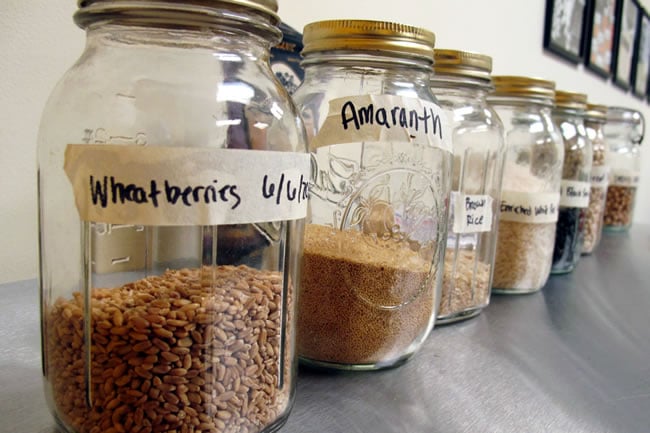
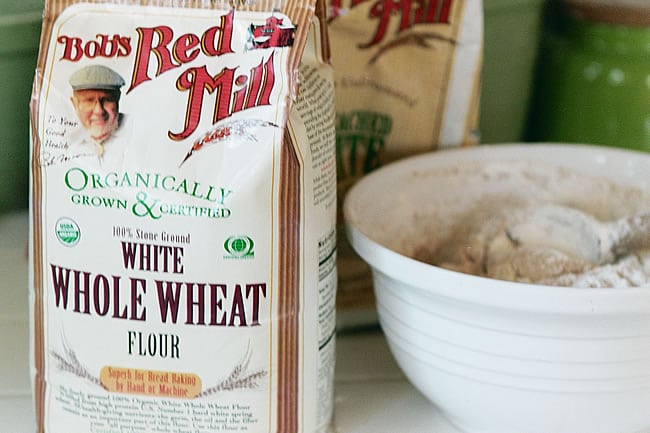
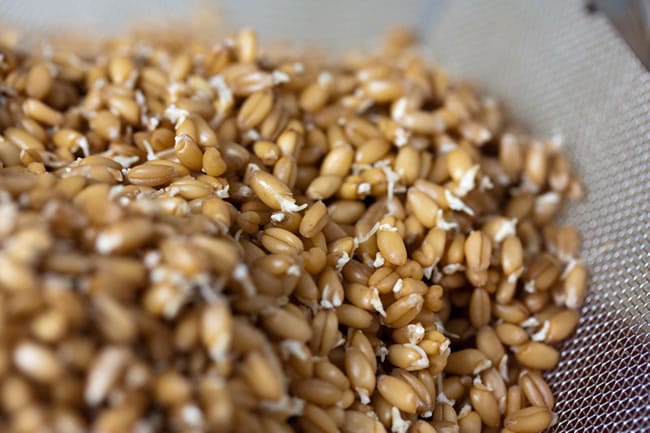
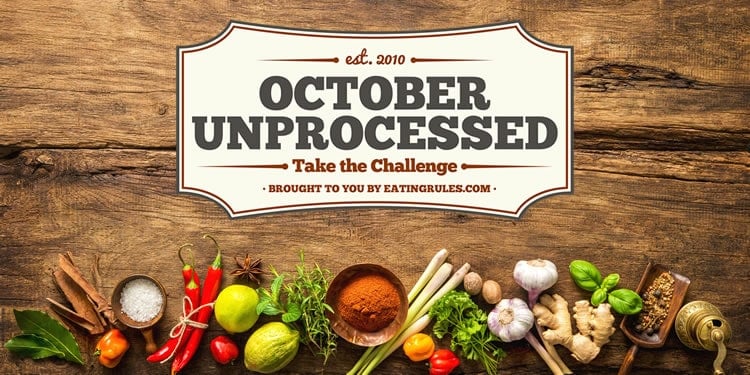
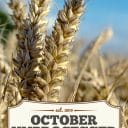




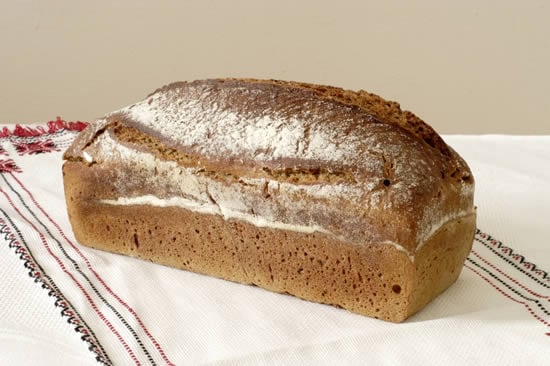















Grains and labeling are so confusing sometimes, even for people who are already living a mostly unprocessed life. The words wheat flour always get me, I have to go back and think to myself “Hey that’s refined!” I use whole wheat white flour ALOT in baking, to me it tastes just like refined flours. We also do a lot of whole wheat pastry flour, oat flour, and spelt. The more you eat it, the more you hate the refined stuff! Thanks for sharing!
I love Ezekiel bread (especially with lettuce, tomato, avocado, sprouts and mustard – but I digress!). But I thought I had seen “gluten” in the ingredients. Not true? We have possible sensitivities in our household to gluten, plus it didn’t seem to fair to call it unprocessed, so I’ve been making our own. It would be nice though if there wasn’t added gluten…
Thanks for the info about the white (aka ivory :>) whole wheat. I’ll give that a try with my bread recipe!
Hi Heather! I don’t think there is added gluten in sprouted breads. But there is gluten because wheat is used. Whole wheat and white whole wheat definitely have gluten, and you might want to avoid them if there is sensitivity in your house. Whole spelt bread also has gluten, but some people with celiac report that even they can eat it with no problems. Millet and rice bread would be gluten free.
The healthiest kind of grains is none at all! 🙂
Re: whole wheat flour, you should look for the caveat, “wheat germ included” on the bag (KA and BRM both have this). In the US, the regulations allow for flour to be called “whole” if it contains +/- 4% of the original components. So here’s the technical breakdown: 83% of the wheat grain is endosperm (white flour). 13% is bran. 3-4% is the wheat germ. So if a company is selling you their flour by breaking into parts, then putting it back together by percentage, you see that they are allowed to leave out the wheat germ and still call it whole. (**sigh**). The claim is that flour will go rancid if they leave the wheat germ in. Not true. It’s actually good as long as 18 mos. If you leave it on a sunny windowsill for a year, well then ….. maybe not! Final suggestion: look for those wonderful… Read more »
Great info. Thanks, Maureen!
quite welcome. I thought this might help your readers while shopping.
Question – on the October Unprocessed Guide, there is a link to make your own sourdough starter. I used to have a starter (that I let die) and wanted to make a new one – but the given instructions call for all purpose flour. Is it possible to use white whole wheat flour instead??
Yes! You can make sourdough from practically any grain… there are some rather geeked out sites that give different water to grain ratios for different grains… in general I have luxk surfing Pinterest when I want to expeeiment making new starters.
Thanks for the sensible comments on white rice. I have talked with so many Americans who think that white rice is an industrial food introduced to Asia only recently. But it’s actually a traditional food, and I have been in remote villages in Thailand with no electricity where they use mechanical means to separate the bran from the rice.
Any good choices for someone who doesn’t live near wheat fields but would like to try grinding her own white whole wheat flour? I have a Vitamix, so that would be the way I’d grind it. I’ve seen lots of sites that will sell you a large quantity or coops who deliver several hundreds of miles away. I’m in the northern Northeast portion of the US, if that helps.
If you’re lucky enough to own a Vitamix, you’ve already got everything you need to grind your own grains! Just add some dry, white wheat berries into your Vitamix and let ‘er rip.
You can use the regular container – though if you’re grinding a lot, you’ll probably want to buy their separate “Dry Grains Container.” Depending on your application, you might also want a sifter/sieve, just to be sure to sift out any larger pieces that may not have been ground up. I clogged up a pasta extruder once…learned my lesson the hard way!
Thanks for the reply Andrew! But *where* do I get the white wheat berries? My local coop only had the hard red wheat berries.
Hard red wheat will work just fine, too — it will just produce a slightly denser bread. Have you asked your co-op if they can get you some white wheat berries? They might be able to special order them for you?
I’m so glad you put a plug in for Bob’s Red Mill Products. I live in Oregon, and Bob’s products really are the best I can buy. At any given time, I probably have at least 2 dozen of his products. I store all opened grains, flours, seeds, etc. in the freezer or refrigerator. Bob recommends this.My favorite bread I bake is made up of 5 flours, 4 seeds. Yum.
Where did you find the recipe for your 5-flour, 4-seed bread?
I am interested to know if any of you are familiar with http://www.againstallgrain.com and what do you think about it.
We have flour and grain in our house, although mostly the kids. I just find myself that some grain products disagree with me and my skin, and I limit them.
That’s how I came across http://www.againstallgrain.com, but I don’t really follow what it preaches, so far.
I am interested in your comments
If there’s a food in existence to which absolutely nobody is allergic or sensitive . . . I’ll be surprised.
“againstallgrain” has some great recipes posted, and the Standard American Diet is certainly too heavy on refined, sweetened, flavored grain-based packaged “treats”! But I don’t think grains are automatically unhealthful for everyone, and if (still open to debate) the Paleo-promoters are right about humanity’s original diet, 15,000 years of natural selection should be enough to ensure that most of us can deal with grains.
Modern, highly-hybridized wheat . . . well, I use it for sandwich bread, but I would like to start working with spelt, kamut, etc. to see what they’re like.
Canadian Readers would be interested in this Globe & Mail article about labeling regulations for Whole wheat and Whole grain products sold in Canada. A farce really.
http://www.theglobeandmail.com/life/health-and-fitness/health/why-whole-grain-health-claims-arent-always-what-they-seem/article4461182/